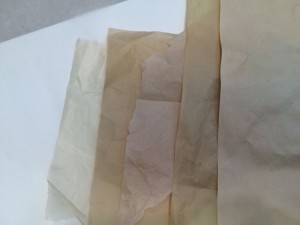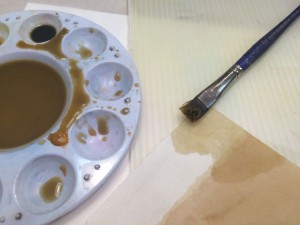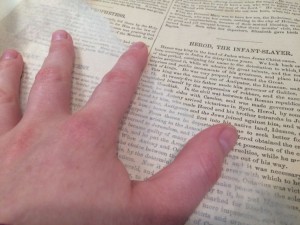In my last post I talked about how many papers are out there for conservators to choose from. It’s great to have so many options, but picking the right one for your situation can be a challenge, the options are often overwhelming.
When making a mend, there are several considerations to take into account. How thick is the paper? How strong is it? Is it very brittle? What color is it? The goal is to create a repair that blends in with the paper, does not obscure any text or image, and successfully stabilizes the piece.
A subtle mend can be achieved by using a slightly colored tissue. You can buy pre-toned tissue, or to get the perfect match sometimes you need to tone your own paper with watercolors or acrylic paints. A thinner tissue often does better at blending into its background, and it may also be semi transparent so text can be read through it. Often times color is less important than transparency. A white tissue that is very thin and transparent will usually blend in well with tan or acid-burned papers without any toning whatsoever.
Perhaps the most tricky of all of these factors is choosing the correct weight and strength of the tissue. A repair paper should be chosen that is as thin as possible to stabilize the paper – usually something slightly weaker than the paper being repaired. This is so that if the paper is ever put into a situation where it is overly stressed, any future tears will occur at the mend rather than somewhere new on the sheet. If a very strong tissue is used to repair a very weak paper then there is a high likelihood that the paper will crack or tear on either side of the new mend since that area is supported while the rest of the page is not. That is why, in the hopes of creating no further damage, a weaker tissue should be chosen. On occasions where the paper is extremely brittle I sometimes choose to line the entire sheet with a piece of thin tissue to create even support.
If a piece of paper has a hole, or loss, the paper chosen to fill in this area will go through different considerations. Typically a paper should be chosen that is the same weight as the paper being mended or something slightly thinner. This is so the original piece will move smoothly and stay supported around the loss. This is especially important in the case of very large losses in a book where pages will be turned and handled regularly.




Thank you Becky. This has been so helpful.